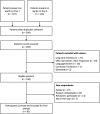Mobile phone access and preferences among medical inpatients at an urban Canadian hospital for post-discharge planning: A pre-COVID-19 cross-sectional survey
- PMID: 36440462
- PMCID: PMC9692091
- DOI: 10.3389/fdgth.2022.928602
Mobile phone access and preferences among medical inpatients at an urban Canadian hospital for post-discharge planning: A pre-COVID-19 cross-sectional survey
Abstract
Background: Digital health interventions are increasingly used for patient care, yet little data is available on the phone access type and usage preferences amongst medical ward inpatients to inform the most appropriate digital interventions post-discharge.
Methods: To identify mobile phone ownership, internet access, and cellular use preferences among medical inpatients, we conducted a researcher-administered survey of patients admitted to five internal medicine units at Vancouver General Hospital (VGH) in January 2020. The survey was administered over 2 days separated by a 2-week period.
Results: A total of 81 inpatients completed the questionnaire. Survey found that 85.2% of survey respondents had mobile phone access where 63.0% owned their own mobile phone, and 22.2% had access to a mobile phone via a proxy (or an authorized third-party) such as a family member. All participants with mobile phone access had cellular plans (i.e., phone and text); however, a quarter of respondents did not have data plans with internet access. Survey showed that 71.1% of males owned a mobile phone compared to only 52.8% of females. All participants at a "high" risk of readmission had access to a mobile phone, either as phone-owners or proxy-dependent users.
Conclusion: Access to mobile phones among medical ward inpatients, 85.2%, was comparable to smartphone penetration rates amongst Canadians in 2019, 85.1%. More patients had cellular than data plans (i.e., internet and applications). Understanding patient-specific access is key to informing potential uptake of digital health interventions aimed at using patients' mobile phones (mHealth) from an effectiveness and equity lens.
Keywords: digital health; health services planning; hospital readmission; mHealth; mobile phone penetration; patient engagement; virtual care.
© 2022 AboMoslim, Babili, Ghaseminejad-Tafreshi, Manson, Fattah, El Joueidi, Staples, Tam and Lester.
Conflict of interest statement
RL has founded WelTel International mHealth Society (a nonprofit organization) and WelTel Inc (a company) to help develop and scale the technologies to deliver the research-based services and has an interest in both organizations. The remaining authors declare that the research was conducted in the absence of any commercial or financial relationships that could be construed as a potential conflict of interest.
Figures
Similar articles
-
Lack of ownership of mobile phones could hinder the rollout of mHealth interventions in Africa.Elife. 2022 Oct 18;11:e79615. doi: 10.7554/eLife.79615. Elife. 2022. PMID: 36255055 Free PMC article.
-
Mobile Phone Access and Implications for Digital Health Interventions Among Adolescents and Young Adults in Zimbabwe: Cross-Sectional Survey.JMIR Mhealth Uhealth. 2021 Jan 13;9(1):e21244. doi: 10.2196/21244. JMIR Mhealth Uhealth. 2021. PMID: 33439136 Free PMC article.
-
Aboriginal and Torres Strait Islander Women's Access to and Interest in mHealth: National Web-based Cross-sectional Survey.J Med Internet Res. 2023 Mar 6;25:e42660. doi: 10.2196/42660. J Med Internet Res. 2023. PMID: 36877565 Free PMC article.
-
Ownership and use of mobile phones among health workers, caregivers of sick children and adult patients in Kenya: cross-sectional national survey.Global Health. 2013 May 14;9:20. doi: 10.1186/1744-8603-9-20. Global Health. 2013. PMID: 23672301 Free PMC article.
-
Mobile Phones May Not Bridge the Digital Divide: A Look at Mobile Phone Literacy in an Underserved Patient Population.Cureus. 2019 Feb 20;11(2):e4104. doi: 10.7759/cureus.4104. Cureus. 2019. PMID: 31057998 Free PMC article.
Cited by
-
Development prospects of "Internet + medical and health services" in Shandong: application status and public acceptance.Front Public Health. 2025 Aug 6;13:1589224. doi: 10.3389/fpubh.2025.1589224. eCollection 2025. Front Public Health. 2025. PMID: 40843430 Free PMC article.
References
-
- Fourth Industrial Revolution. World economic forum. Available at: https://www.weforum.org/focus/fourth-industrial-revolution (Accessed April 02, 2021).
-
- Smartphone ownership is growing rapidly around the world, but not always equally. Pew research center. Available at: https://www.pewresearch.org/global/2019/02/05/smartphone-ownership-is-gr... (Accessed April 02, 2021).
-
- Market Research Reports. Digital health market revenue of US$536.6 bn by the end of 2025: technology advancement and innovation - press release - digital journal. Market research reports (2017). Available at: http://www.digitaljournal.com/pr/3518555 (Accessed April 02, 2021).
-
- Ryu S. mHealth: new horizons for health through mobile technologies: based on the findings of the second global survey on ehealth (global observatory for ehealth series, volume 3). Healthc Inform Res. (2012) 18(3):231. 10.4258/hir.2012.18.3.231 - DOI
-
- Salud OM de la. WHO | medical device – full definition. World Health Organization (2013). p. 1. Available at: https://www.who.int/medical_devices/full_deffinition/en/ (Accessed April 02, 2021).
LinkOut - more resources
Full Text Sources




